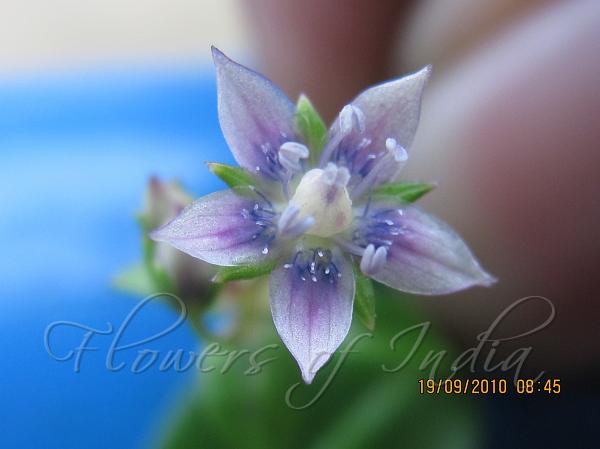|
| Large-Seed Swertia |
|

|

| File size | 461105 |
| Original date | 9/19/10 8:45 AM |
| Resolution | 2272 x 1704 |
| Flash | Flash did not fire, auto |
| Focal length | 6.0mm |
| Exposure time | 1/160s |
| Aperture | 2.8 |
| Focus Distance | |
| Metering Mode | Multi-segment |
| Camera make | Canon |
| Camera model | Canon PowerShot SX120 IS |
| Sensor type | OneChipColorArea |
|
|
|
|
Photo: |
Botanical name: Swertia macrosperma Family: Gentianaceae (Gentian family)
Synonyms: Swertia scandens, Swertia randaiensis, Ophelia macrosperma
Synonyms: Swertia scandens, Swertia randaiensis, Ophelia macrosperma
Large-Seed Swertia is an annual herb 1-3 ft tall.
Flowers are white or pale blue, 5- or rarely 4-merous, 3-5 mm in
diameter, tube about 0.5 mm; petals elliptic, 4-8 mm, tip blunt, with 2
hairy, cupshaped nectaries 2 per petal. Filaments are 4-5 mm; anthers
ellipsoid, about 1.5 mm. Style indistinct; stigma lobes headlike.
Sepal-tube is about 0.5 mm; sepals ovate-elliptic, 2.5-4 mm, tip
pointed, midvein distinct. Flower-stalks are erect, 4-15 mm, slender.
Flowers are borne in panicles of cymes, many flowered, spreading
branched. Stems are erect, 4-angled narrowly winged on angles, branched
from middle. Basal and lower stem leaves wither at flowering, stalked;
leaf blade spoon-shaped, 2-6.5 x up to 1.5 cm, base narrowed, margin
entire or finely toothed, tip blunt, veins 1-3. Middle stem leaves are
stalkless, lanceshaped, oblong, ovate, or rarely obovate, 0.4-4.5 x
0.3-1.5 cm, base blunt, tip pointed, veins 3-5. Capsules are ovoid, 5-6
mm. Seeds 3-4 per capsule, brown, ellipsoid to almost spherical, 1.5-2
mm. Large-Seed Swertia is found growing beside streams, grasslands on
hillsides, scrub, mixed forests, bamboo thickets, at altitudes of
1400-4000 m, in Eastern Himalayas, from Nepal to NE India, S. China and
N. Myanmar, Taiwan. Flowering: July-November.
Medicinal uses: Large-Seed Swertia is a
traditional folk medicine used for its anti-hepatitis, antipyretic and
antidotal effects as Dida or Zangyinchen in Tibet, Yunnan and
Guizhou province for a long time, and it has been reported for its
anti-diabetic effects in a Chinese patent.
Large-Seed Swertia is a
traditional folk medicine used for its anti-hepatitis, antipyretic and
antidotal effects as Dida or Zangyinchen in Tibet, Yunnan and
Guizhou province for a long time, and it has been reported for its
anti-diabetic effects in a Chinese patent.
Medicinal uses:
 Large-Seed Swertia is a
traditional folk medicine used for its anti-hepatitis, antipyretic and
antidotal effects as Dida or Zangyinchen in Tibet, Yunnan and
Guizhou province for a long time, and it has been reported for its
anti-diabetic effects in a Chinese patent.
Large-Seed Swertia is a
traditional folk medicine used for its anti-hepatitis, antipyretic and
antidotal effects as Dida or Zangyinchen in Tibet, Yunnan and
Guizhou province for a long time, and it has been reported for its
anti-diabetic effects in a Chinese patent. | Identification credit: Saroj Kasaju | Photographed in Arunachal Pradesh. |
• Is this flower misidentified? If yes,